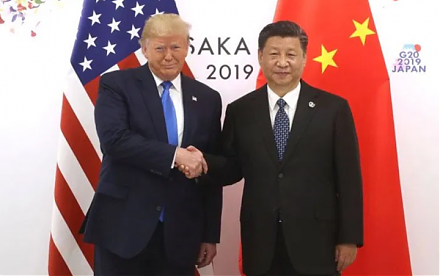

2022-05-30 09:32:00 Mon ET
stock market technology facebook covid-19 apple microsoft google amazon data platform network scale artificial intelligence antitrust alpha patent model tech titan tesla global macro outlook machine software algorithm intel semiconductor tsmc
Our current fundamental macro analysis focuses on the global supply chain issues and semiconductor microchip shortages in response to the persistent demands of U.S. tech titans Meta, Apple, Microsoft, Google, and Amazon (MAMGA). The new semiconductor microchip demand-supply imbalance remains quite severe for the U.S. tech and auto industries. It can take several years for the core semiconductor microchip manufacturers to build out new capacity during the boom-bust business cycle. We expect adequate microchip supplies to meet tech and auto demands in 2023-2025 as the recent semiconductor capital investments begin to bear fruit in due course. This macro trend has profound public policy implications for U.S. tech titans Meta, Apple, Microsoft, Google, Amazon, Nvidia, Tesla, Intel, and IBM etc.
Each semiconductor microchip is a set of electronic circuits on the top of thin wafer. Transistors serve as miniature electrical switches on the semiconductor microchip. These transistors can turn each electrical current on or off over time. Substantially greater capacity means more transistors on each semiconductor microchip. As the size of a human fingernail, each microchip contains billions of transistors. Moore’s law suggests that the number of transistors from a dense integrated circuit doubles about every 2 years. This law sets the unique tone for the semiconductor sector in high technology from mobile software and social media to e-commerce and cloud service provision etc.
There are 3 main types of semiconductor microchip companies. Integrated Device Manufacturers (IDMs) Intel and Samsung etc design and manufacture microchips in-house. Fabless companies such as Qualcomm and AMD design microchips in-house but outsource manufacturing tasks worldwide. Microchip foundries such as TSMC and MediaTek manufacture microchips for fabless companies as well IDMs. In effect, microchip foundries retain sufficient in-house semiconductor production capacity in order to support both IDMs and fabless companies in the long run.
Semiconductor microchips are both the building blocks and hardware foundations of high technology. These microchips are central inputs in many everyday devices such as cars, computers, mobile phones, medical devices, and robots. There are 3 main types of semiconductor microchips: logic microchips, memory microchips, and discrete, analog, and other (DAO) microchips. Logic microchips are the brains of both electronic devices and components. These microchips process information in order to complete specific tasks such as system integration and analysis. Central processing units (CPU) are built for general functionality; graphics processing units (GPU) often optimize computer performance for visual representation; and neural processing units (NPU) specifically help with many machine learning applications and algorithms such as random forests, extreme gradient boosters, support vector machines, and neural networks. Apart from logic microchips, memory microchips help store information. DRAM microchips specifically save data when the end user turns on each device, and NAND microchips save data after the end user turns off each device. DAO microchips transmit, receive, and transform real-time data and information with continuous parameters such as temperature and precipitation.
In light of recent semiconductor microchip shortages worldwide, the vast majority of IDMs, fabless companies, and foundries manufacture most microchips in China, Taiwan, South Korea, Japan, and Europe. These oligopolistic competitors produce semiconductor microchips outside America. For this reason, the recent microchip shortages have become a major national security concern for U.S. tech titans Meta, Apple, Microsoft, Google, Amazon, Nvidia, Tesla, and Twitter etc.
Semiconductor microchips have been central to the multimedia functionality of new products that we use in our daily lives for many years. Inside every mobile phone, computer, and vehicle, semiconductor microchips store and process digital data in vast volume. There are now approximately 50 to 60 semiconductor microchips in each iPhone and more than hundreds of microchips in each electric car. This core number of microchips grows as the amount of electronic capacity continues to rise over time. For example, the autonomous features that most electric cars apply now require substantial semiconductor power. Improvements in microchip technology have led to a significant increase in computational power. Mobile phones, devices, computers, and cars can become more powerful in performance with less electrical power consumption. If the world now heads towards the metaverse, the essential need for semiconductor microchip power can significantly grow over the next few decades. This macro trend makes microchips even more important in due course. In light of recent semiconductor microchip shortages worldwide, both demand and supply factors and considerations come into play across the industry spectrum of oligopolistic competition among the IDMs, fabless companies, and foundries.
The pandemic shifts in demand and supply have been a major culprit of prevalent microchip shortages; however, the fundamental factors behind the demand-supply imbalance have already in place since the current corona virus crisis of 2020-2022. The semiconductor sector has grown at a double-digit pace in the past 50+ years. Due to Intel co-founder Gordon Moore, Moore’s law suggests that the number of transistors on each microchip would double every 18-24 months as the cost would remain the same. In response to the recent digital transformation of global society, the semiconductor sector has been growing global sales at the 6%-8% cumulative annual growth rate in the period from 2010 to 2022. The pandemic crisis seems to have accelerated this digital transformation as people increasingly work, transact, and seek entertainment online.
In the meantime, the global supply of semiconductor microchips has grown only at a moderate pace. In recent years, the IDMs, fabless companies, and foundries etc have been cautious in ramping up production capacity since these manufacturers experienced setbacks and hardships during the earlier brutal business cycles such as the dotcom bubble of 2001-2002 and the Global Financial Crisis of 2008-2009. Capital investments in mature microchip technology with node sizes from 22 nano-meters to 180 nanometers have been especially low over the last decade, in stark contrast to the leading-edge technology with node sizes from 5 nanometers to 12 nanometers. Although the supply of leading edge technology seems a bit tight, this global supply chain remains robust. For this technical reason, the current microchip shortages are likely to cause larger negative consequences in the auto industry (in comparison to the free markets for smart phones, computers, electronic appliances, and other mobile devices).
There is no much room for the IDMs, fabless companies, and foundries etc to ramp up their current microchip production capacity. On the global supply chain, capacity utilization rates for mature technology are well above 95%. Most of the wafer fabs turn thin wafers (e.g. silicon) into semiconductor microchips. These manufacturers have been running at full capacity since the current pandemic crisis of 2020-2022. It would take at least 18-24 months for most microchip manufacturers to increase their production capacity. Also, it can take 2.5 to 3 years for these manufacturers to build their wafer fabs. Fabless companies and foundries often need to buy the equipment to manufacture semiconductor microchips. Equipment lead times have increased to 10 to 12 months amid the recent surge in microchip demand from U.S. tech titans and end customers. The reasonable size of the market for wafer front-end equipment has grown from $35 billion in 2015 to $80+ billion in 2020-2022. It often takes a long time for the IDMs, fabless companies, and foundries to generate tangible results in sales and profits for building new capital-intensive wafer fabs.
In China, Taiwan, South Korea, Japan, and some parts of Europe, plant shutdowns have contributed to the long response times in this capital-intensive process. Chip productivity is now back up to somewhat normal levels, so plant shutdowns might have contributed to maybe 3-month delays in microchip production. High-skill labor shortages have further impacted some major U.S. capital equipment suppliers. In this negative light, equipment lead times have increased from about 2 quarters to more than 4 quarters in the same capital-intensive process.
Many original equipment manufacturers (OEM) (e.g. Foxconn and Pegatron) and U.S. tech titans Meta, Apple, Microsoft, Google, and Amazon (MAMGA) now try to design their own microchips either by themselves or with chipmakers. In the smart phone and computer markets, OEMs strengthen their global supply chain relations. From Apple and Microsoft to Meta and Google, more of these customers now sign memorandums of understanding (MOU) with TSMC and MediaTek etc with at least 2-year global supply chains (especially in China, Taiwan, and Japan). These U.S. tech titans start to focus on their longer-term strategic relations with the upstream suppliers of semiconductor microchips. This prescient focus can continue after the current corona virus crisis of 2020-2022. Some other smaller tech companies may revert to more transactional relations with OEMs for cost-effective reasons.
Unfortunately, it can take quite a few years for the IDMs, fabless companies, and foundries to fully resolve semiconductor microchip shortages in the global supply chains. In recent times, there are some incremental improvements in the demand-supply imbalance on the margin. For smart phones and computers, the global end demand has begun to ease from the pandemic peaks. As consumers switch from 4G to 5G mobile devices (smart phones and tablets), global sales for these mobile devices have fallen in the past 2 to 3 years. Major OEMs now have about 5-month inventories. This level is quite tight for their typical business requirements, but this status quo is no longer a hand-to-mouth situation.
The semiconductor microchip demand-supply imbalance remains quite severe for the U.S. tech and auto industries. It can take several years for the semiconductor microchip manufacturers to build out new capacity during the boom-bust business cycle. Adequate microchip supplies are likely to meet both tech and auto demands in 2023-2025 as the current semiconductor capital investments begin to bear fruit in due course. Many industrial economists expect a gradual move toward a better balance between semiconductor microchip demand and supply over the next few years. New sources of microchip demand are likely to arise from the core hardware for building out the global metaverse. This macro trend has profound public policy implications for U.S. tech titans Meta, Apple, Microsoft, Google, Amazon, Nvidia, Tesla, Intel, and IBM etc.
As tech products become better and cheaper, the success of Moore’s law has led to the empirical fact that semiconductor microchips can deliver higher performance in a cost-effective manner. Now iPhones harness 100,000 times more computing power than the computer that sent astronauts to the moon in the late-1960s. Over the recent decades, the semiconductor sector keeps a track record of overcoming numerous business, technical, and even political challenges. The semiconductor sector can continue to provide significant value to consumers in due course. In this positive light, the semiconductor microchip shortages and supply chain issues are likely to ease in the longer run.
The U.S. continues to be a key high-tech hub. Semiconductor sector concentration has grown substantially over the past 35 years, particularly in Taiwan, China, and South Korea. The semiconductor sector has always been capital-intensive. Many disruptive innovators implement high-tech practical applications on semiconductor microchips. Only the top 2 to 5 tech titans consistently make good money in mobile connectivity, software, online search, e-commerce, renewable energy generation, social media, and cloud service provision etc. For instance, Apple captures at least 75% of the profits in the global market for smart phones. TSMC and MediaTek can manage their capital investments in semiconductor microchip production to attract strong returns. These returns feed back into fresh R&D and capacity utilization. In practice, most tech companies prefer not to operate in this self-reinforcing cycle as this cycle carries significant risks for shareholders. For this reason, most U.S. tech titans rely on TSMC and MediaTek etc for their microchip production capacity and capital equipment technology.
Taiwan has a huge cluster of wafer fabs as well as all the tech industries in support of both fabless companies and foundries. Together with Moore’s law, this efficiency has allowed tech products to become better and cheaper in the last few decades. Breaking up this cluster is likely to elongate the pace of disruptive innovations with higher costs. Most governments tend to bolster this high-tech cluster with probably less intervention. The burden of semiconductor sector de-concentration would fall on consumers worldwide. Free market capitalism dictates the economic costs and benefits of semiconductor sector concentration for better global sales and profits.
In recent years, the digital transformation has led to pervasive technology adoption in the financial services sector. This tech adoption causes new sources of systemic risk in financial services worldwide. In due course, these new sources of systemic risk affect almost all of the major market players in the global financial system. The major market players include banks, insurers, asset managers, exchanges, as well as financial infrastructure providers. Systemic risk events often emerge, grow, and spread across heavily interconnective financial products, services, and regions. In practice, financial service providers such as banks and insurers may inadvertently become too big to fail in rare times of severe systemic risk (e.g. the dotcom bubble of 2001-2002, Global Financial Crisis of 2008-2009, and current corona virus crisis of 2020-2022). When push comes to shove, the law of inadvertent consequences counsels caution.
The current sources of systemic risks refer to the short-term and longer-term cases where economic uncertainty leads to severe losses in the broader financial system. When these severe losses materialize as ecosystem events, these rare events can contribute to the development of systemic risk worldwide. In rare times of financial stress, this systemic risk causes financial contagion from one region to another. It has become important for financial institutions and regulators to assess their extant exposure across various sources of systemic risk to better anticipate the economic outcomes of rare events in the financial services sector worldwide. These sources of systemic risk include market risk, credit risk, operational risk, legal risk, strategic risk, reputation risk, procyclicality risk, and so forth.
With some critical tech service providers, new interconnections and dependencies significantly contribute to vulnerable nodes with respect to the essential functions of the broader financial system. These essential functions include bank transfers, interbank payments, user authentication keys, and asset portfolio alpha combos. Across external financial system policies, the lack of common taxonomy presents extensive uncertainty for how financial institutions anticipate systemic risk events. Cyber attacks, cross-border data debacles, and other illicit tech-driven events pose systemic risks to financial stability, consumer protection, and market integrity. In a fundamental view, home-host coordination can help address at least some of these concerns. On the other hand, incompatible nation-state methods may inadvertently cause harm to the global financial system. New sources of systemic risk can further create unforeseen opportunities for financial market manipulation. As technology has been instrumental in promoting greater financial inclusion, several inadvertent consequences may arise from algorithmic biases, exclusionary practices, and anti-competitive behaviors. These repercussions can hinder global financial prosperity, stability, and economic growth.
Both financial institutions and regulators have learned many lessons from past risk management efforts in the financial services sector worldwide. In order to measure systemic risk, each financial market innovator has to resolve significant information asymmetries between financial institutions and consumers. When each disruptive innovator continues his or her digital transformation, this transformation often has to offer new and non-obvious dynamic conditional methods for better financial risk management. Both private-sector and public-sector market participants should be conscious of their relations with external service providers. Broad vendor networks can help reduce over-reliance on the various functions and capabilities of a single vendor. This diversification accords with the essential need for each competitor to sustain business relations with multiple upstream suppliers and third-party service providers. When financial market players outsource critical business functions to external third-party service providers, regulators often need to ring-fence assets in support of core business operations elsewhere within the financial system.
Multilateral approaches can help create new incentives for disruptive innovators to scale up core business functions, financial services, data transfer operations (such as application programming interfaces (API) and software development kits (SDK)), asset portfolio alpha combos, financial ratios, financial statements (balance sheets, income statements, and cash flow statements), and compound interest strategies. Public-sector regulators often analyze the broad range of financial services under the purview of both financial supervision and regulation. This analysis helps ensure adequate regulatory coverage across the industry spectrum. There is no one-size-fits-all solution. For instance, greater technology adoption can help connect better digital inclusion to financial literacy through education and social integration. There can be many different ways for financial economists to skin the cat, and all roads eventually lead to Rome. Yet, no one can build Rome in one day.
Several empirical results summarize how financial market players need to respond to the role that new technology plays in amplifying systemic risks in global financial services. Some non-financial market competitors contribute to a disproportionate share of systemic risk. Disruptive innovators such as LendingClub and PayPal can pose systemic risk threats because these non-financial market players collaborate with banks, insurers, and even asset managers etc in the broader financial system. Nowadays, the traditional determinants of systemic importance have become less relevant than the size of the wider fintech network platform. For LendingClub and PayPal, the size of active membership matters more than the traditional measures such as total assets, sales, and common stock values. In the broader global macro environment, systemic risk interconnections are no longer bilateral. As the number of interconnections between service providers continues to grow, financial market players often need to comprehensively understand their entire systemic exposure. As stochastic rare events grow in both loss severity and frequency (such as cyber attacks and climate changes etc), financial market players should learn to deploy core forward-looking risk prevention and detection mechanisms. To combat cyber crime and financial crime, financial market players should undertake joint efforts to account for inconsistent or incompatible nation-state methods with multilateral data transfer protocols. These collective foundational solutions help enhance financial risk management with coherent home-host coordination frameworks.
Nobel Laureate Robert Shiller (2005) refers to several asset bubbles as substantial persistent stock market and residential real estate price hikes. In his classical book Irrational Exuberance, Shiller applies the S&P Case-Shiller Home Price Indices to gauge the extent of excessive house price appreciation across America from 2000 to 2006. In many states and counties, house prices exceed their long-term average equilibrium counterparts by 30% to even 45%. Many banks and non-bank financial institutions extend private credits to home owners via first mortgages, home equity loans, and home equity credit lines. The resultant lax mortgage loan underwriting standards suggest that many mortgage loans turn out to be subprime with poor or low FICO borrower credit scores at higher current loan-to-value (LTV) ratios. As a result, this rare and unique combination eventually leads to massive mortgage loan defaults in America because many borrowers cannot repay the mortgage principal and interest payments. Some of the big banks such as Bear Stearns and Lehman Brothers cannot sustain during such financial turmoil. Credit contagion spreads to many other parts of the world such as Britain, Canada, Europe, Japan, and South East Asia etc. The Global Financial Crisis of 2008-2009 results in substantial stock market price declines as well as a major loss of investor confidence in credit default swaps, corporate debt obligations, and other financial derivative products.
In order to tame animal spirits in asset markets, Nobel Laureates George Akerlof and Robert Shiller (2009) call for greater transparency, better financial disclosure, and new economic measurement made more informative for the general public. In this fundamental sense, investors, shareholders, borrowers, or other stakeholders should be able to decipher core information cascades from complex and esoteric financial reports (such as the Balance Sheets, Income Statements, and Cash Flow Statements). U.S. banks and other financial institutions should make it possible for most borrowers to refinance their residential mortgage loans even when mortgage delinquency rates are on the rise. Most investors should be able to penetrate asset portfolios far enough to make their own financially wise and savvy decisions.
At each step of the information chain, one side knows significantly more than the other about the basic structure of securities. In asset securitization, the bank loan originator often knows more about the actual credit quality of assets (mortgages or home equity credit lines etc), whereas, most investors and borrowers lack this core information. Due to these information asymmetries, most investors can have better confidence in the senior tranche of securities with top Aaa credit grades. As banks transfer basic assets (mortgages, home equity loans, home equity credit lines, and corporate bonds etc) to the special purpose vehicle (SPV), the SPV ensures that the senior tranche of securities can retain top credit quality for only 10% to 15% of the basic assets. The mezzanine and junior equity tranches ultimately lose value when most investors lose confidence in the credit quality of the basic assets. Credit contagion triggers the flight to top credit quality as the mezzanine and junior equity tranches of securities become worthless during the U.S. subprime mortgage crisis and Global Financial Crisis of 2008-2009. When banks originate the basic assets (mortgages, home equity loans, home equity credit lines, and corporate bonds etc) and then distribute various tranches of new securities to both institutional and retail investors, the originate-and-distribute model places blame on the underwriters who foresee no or little exposure to credit concentration risk. Financial trouble can arise from the lax mortgage loan underwriting standards and opaque derivative systems worldwide.
At the same time, bank insolvency fears naturally reduce interbank loans with run-on repo contracts. These fears cause temporary disruptions in the price discovery system of short-term corporate debt markets. A lack of liquidity further exacerbates the Global Financial Crisis. The substantial premium between the mark-to-market values and the actuarial fair values results in a vicious circle of collateral damage. Loose mortgage loan underwriting standards tend to benefit first-time homebuyers who would not otherwise afford to buy residential real estate properties. Numerous home owners who have not defaulted on their mortgage loans become better off. In contrast, those households who have defaulted on their mortgage loans become financially worse off. Some households choose to strategically default on their first mortgages with better access to short-run liquidity through home equity credit lines because it is simply more profitable for these households to do so. As Akerlof and Shiller (2009) suggest in their core thesis, strategic mortgage defaults sometimes reflect animal spirits and self-interests in light of proper economic incentives in the market for lemons (e.g. second-hand cars or subprime mortgage loans etc).
Akerlof and Shiller (2009) recommend 2 macro stimulus programs for restoring the economic equilibrium that encompasses the whole U.S. mortgage credit chain. No one has any incentive to rock the boat in equilibrium until residential property prices start to decline dramatically over the short run. First, the proper fiscal and monetary stimulus programs include zero interest rates and the Treasury emergency liquidity provision to the mega banks. The Federal Reserve System, Congress, and Council of Economic Advisers often seem to favor rebuilding the mortgage credit markets over the medium-term pursuit of full employment. Second, the unconventional use of quantitative-easing (QE) large-scale asset purchases (e.g. mortgage securities, credit default swaps, and corporate debt obligations) injects short-term liquidity into the mortgage credit markets. Over several years, the American political economy of both zero interest rates and QE large-scale asset purchases helps achieve the dual mandate of price stability and maximum sustainable employment. In the future, the IMF and World Bank must learn to build macro automatic stabilizers for dealing with the weakest link of credit contagion worldwide. Such automatic stabilizers can help better ring-fence subprime mortgage defaults and other information cascades. In principle, this macro asset market stabilization helps prevent domestic financial crises from triggering global rare disasters in most asset markets.
As of mid-2022, we provide our proprietary dynamic conditional alphas for the U.S. top tech titans Meta, Apple, Microsoft, Google, and Amazon (MAMGA). Our unique proprietary alpha stock signals enable both institutional investors and retail traders to better balance their key stock portfolios. This delicate balance helps gauge each alpha, or the supernormal excess stock return to the smart beta stock investment portfolio strategy. This proprietary strategy minimizes beta exposure to size, value, momentum, asset growth, cash operating profitability, and the market risk premium. Our unique proprietary algorithmic system for asset return prediction relies on U.S. trademark and patent protection and enforcement.
Our unique algorithmic system for asset return prediction includes 6 fundamental factors such as size, value, momentum, asset growth, profitability, and market risk exposure.
Our proprietary alpha stock investment model outperforms the major stock market benchmarks such as S&P 500, MSCI, Dow Jones, and Nasdaq. We implement our proprietary alpha investment model for U.S. stock signals. A comprehensive model description is available on our AYA fintech network platform. Our U.S. Patent and Trademark Office (USPTO) patent publication is available on the World Intellectual Property Office (WIPO) official website.
Our core proprietary algorithmic alpha stock investment model estimates long-term abnormal returns for U.S. individual stocks and then ranks these individual stocks in accordance with their dynamic conditional alphas. Most virtual members follow these dynamic conditional alphas or proprietary stock signals to trade U.S. stocks on our AYA fintech network platform. For the recent period from February 2017 to February 2022, our algorithmic alpha stock investment model outperforms the vast majority of global stock market benchmarks such as S&P 500, MSCI USA, MSCI Europe, MSCI World, Dow Jones, and Nasdaq etc.
This analytic essay cannot constitute any form of financial advice, analyst opinion, recommendation, or endorsement. We refrain from engaging in financial advisory services, and we seek to offer our analytic insights into the latest economic trends, stock market topics, investment memes, personal finance tools, and other self-help inspirations. Our proprietary alpha investment algorithmic system helps enrich our AYA fintech network platform as a new social community for stock market investors: https://ayafintech.network.
We share and circulate these informative posts and essays with hyperlinks through our blogs, podcasts, emails, social media channels, and patent specifications. Our goal is to help promote better financial literacy, inclusion, and freedom of the global general public. While we make a conscious effort to optimize our global reach, this optimization retains our current focus on the American stock market.
This free ebook, AYA Analytica, shares new economic insights, investment memes, and stock portfolio strategies through both blog posts and patent specifications on our AYA fintech network platform. AYA fintech network platform is every investor's social toolkit for profitable investment management. We can help empower stock market investors through technology, education, and social integration.
We hope you enjoy the substantive content of this essay! AYA!
Andy Yeh
Chief Financial Architect (CFA) and Financial Risk Manager (FRM)
Brass Ring International Density Enterprise (BRIDE) ©
Do you find it difficult to beat the long-term average 11% stock market return?
It took us 20+ years to design a new profitable algorithmic asset investment model and its attendant proprietary software technology with fintech patent protection in 2+ years. AYA fintech network platform serves as everyone's first aid for his or her personal stock investment portfolio. Our proprietary software technology allows each investor to leverage fintech intelligence and information without exorbitant time commitment. Our dynamic conditional alpha analysis boosts the typical win rate from 70% to 90%+.
Our new alpha model empowers members to be a wiser stock market investor with profitable alpha signals! The proprietary quantitative analysis applies the collective wisdom of Warren Buffett, George Soros, Carl Icahn, Mark Cuban, Tony Robbins, and Nobel Laureates in finance such as Robert Engle, Eugene Fama, Lars Hansen, Robert Lucas, Robert Merton, Edward Prescott, Thomas Sargent, William Sharpe, Robert Shiller, and Christopher Sims.
Follow AYA Analytica financial health memo (FHM) podcast channel on YouTube: https://www.youtube.com/channel/UCvntmnacYyCmVyQ-c_qjyyQ
Follow our Brass Ring Facebook to learn more about the latest financial news and fantastic stock investment ideas: http://www.facebook.com/brassring2013.
Free signup for stock signals: https://ayafintech.network
Mission on profitable signals: https://ayafintech.network/mission.php
Model technical descriptions: https://ayafintech.network/model.php
Blog on stock alpha signals: https://ayafintech.network/blog.php
Freemium base pricing plans: https://ayafintech.network/freemium.php
Signup for periodic updates: https://ayafintech.network/signup.php
Login for freemium benefits: https://ayafintech.network/login.php
We update and refresh part of memetic financial information on a sporadic basis. We aim to facilitate this information exchange only for illustrative purposes. Some information may be stale and incomplete. Therefore, we recommend each member to consult the respective external website(s) for more up-to-date information.
This analytic report cannot constitute any form of financial advice, analyst opinion, recommendation, or endorsement. We refrain from engaging in financial advisory services, and we seek to offer our analytic insights into the latest economic trends, stock market topics, investment memes, and other financial issues. Our proprietary alpha investment algorithmic system helps enrich our AYA fintech network platform as a new social community for stock market investors: https://ayafintech.network.
The conventional disclaimers apply to this key case where each freemium member bewares, understands, and acknowledges the service terms and conditions for our courteous fintech network platform. Any omissions, errors, or other blemishes do not necessarily reflect the official views and opinions of our AYA fintech platform orchestrator. We make a conscious effort to keep most major omissions to 1% to 5% of the fintech information for about 6,000 U.S. stocks on NYSE, NASDAQ, and AMEX. These omissions tend to concentrate around some rare corporate events (e.g. IPO, delisting occurrence and recurrence, abrupt trading suspension, and M&A initiation etc). Overall, these disclaimers, terms, and conditions of our service should be viewed as baseline house rules for fintech network platform usage and development.
Under pending subsequent patent-law confirmation, the relevant legal text protects our proprietary alpha software technology for ubiquitous knowledge transfer. Each freemium member enjoys his or her interactive usage and information exchange on our AYA algorithmic fintech network platform with sound and efficient dynamic conditional asset return prediction.
Our AYA fintech network platform helps promote better financial literacy, inclusion, and freedom of the global general public with an abiding interest in core economic reforms, financial markets, and stock market investments. In this broader context, each freemium member can consult our mission statement that provides more in-depth explanatory details on our long-term aspiration.
If any of our AYA Analytica financial health memos (FHM), blog posts, ebooks, newsletters, and notifications etc, or any other form of online content curation, involves potential copyright concerns, please feel free to contact us at service@ayafintech.network so that we can remove relevant content in response to any such request within a reasonable time frame.
2018-07-19 18:38:00 Thursday ET

Goldman Sachs chief economist Jan Hatzius proposes designing a new Financial Conditions Index (FCI) to be a weighted-average of interest rates, exchange rat
2019-07-27 17:37:00 Saturday ET

Capital gravitates toward key profitable mutual funds until the marginal asset return equilibrates near the core stock market benchmark. As Stanford finance
2020-01-01 13:39:00 Wednesday ET

President Trump approves a phase one trade agreement with China. This approval averts the introduction of new tariffs on Chinese imports. In return, China s
2018-12-11 10:34:06 Tuesday ET

Several eminent American China-specialists champion the key notion of *strategic engagement* with the Xi administration. From the Hoover Institution at Stan
2023-09-28 08:26:00 Thursday ET

Daron Acemoglu and James Robinson show a constant economic tussle between society and the state in the hot pursuit of liberty. Daron Acemoglu and James R
2019-07-21 09:37:00 Sunday ET

Facebook introduces a new cryptocurrency Libra as a fresh medium of exchange for e-commerce. Libra will be available to all the 2 billion active users on Fa